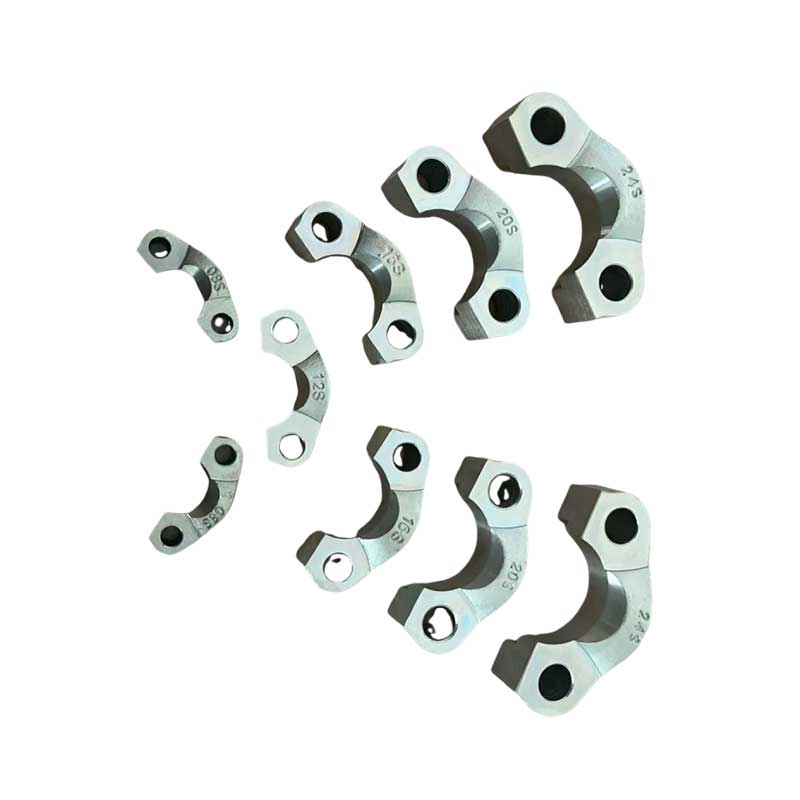Overview of SAE Split Flanges
2024-05-24
An SAE split flange is a type of hydraulic flange used to connect tubes, pipes, and hoses in high-pressure hydraulic systems. The term "SAE" stands for the Society of Automotive Engineers, which sets standards for various automotive and aerospace components, including hydraulic flanges. Here's a detailed overview of SAE split flanges:
Overview of SAE Split Flanges
1. Purpose:
- Connection: Provides a secure and leak-free connection for hydraulic lines.
- High-Pressure Applications: Designed to handle high-pressure conditions commonly found in hydraulic systems.
2. Design:
- Split Design: Composed of two halves (clamps) that are bolted together around the flange head.
- Bolt Pattern: Typically features a standardized bolt pattern that ensures compatibility with SAE specifications.
Key Features
1. Construction:
- Materials: Usually made from high-strength steel or stainless steel to withstand high pressures and harsh environments.
- Surface Treatment: Often coated or treated to resist corrosion and wear.
2. Sealing Mechanism:
- O-Ring Seals: Utilizes O-ring seals to prevent fluid leakage. The O-ring is seated in a groove on the flange face.
- Flange Face: Designed to ensure a tight seal when the bolts are torqued to specification.
3. Installation:
- Ease of Assembly: The split design allows for easy installation and removal, especially in confined spaces.
- Bolt Torquing: Requires proper torque application on the bolts to ensure a leak-free seal and maintain system integrity.
Applications
1. Hydraulic Systems:
- Industrial Machinery: Used in hydraulic systems for construction equipment, agricultural machinery, and industrial machinery.
- Mobile Equipment: Common in hydraulic systems of trucks, excavators, and other heavy equipment.
2. Automotive and Aerospace:
- High-Pressure Lines: Used in automotive and aerospace applications where high-pressure hydraulic lines are present.
3. Marine:
- Marine Hydraulics: Suitable for use in marine hydraulic systems due to their durability and corrosion resistance.
Advantages
1. Leak-Free Connection:
- Provides a reliable and leak-free connection, essential for maintaining hydraulic system efficiency.
2. High-Pressure Capability:
- Designed to handle high-pressure applications, making them suitable for demanding hydraulic systems.
3. Easy Installation and Maintenance:
- The split design facilitates easy assembly and disassembly, reducing downtime during maintenance.
Disadvantages
1. Cost:
- High-quality SAE split flanges can be relatively expensive compared to other types of fittings.
2. Installation Precision:
- Requires careful installation and proper torquing of bolts to ensure a leak-free connection and prevent damage to the O-ring seal.
Standards and Specifications
1. SAE J518:
- Standard: SAE J518 is the standard that specifies the dimensions, materials, and performance requirements for split flanges.
- Specifications: Includes details on flange sizes, bolt sizes, and torque values.
2. ISO 6162:
- International Standard: ISO 6162 provides an international equivalent to SAE J518, ensuring global compatibility.
Maintenance and Care
1. Regular Inspection:
- Leak Checks: Regularly inspect for leaks around the flange connection and tighten bolts as necessary.
- O-Ring Condition: Check the condition of the O-ring seal and replace it if any signs of wear or damage are present.
2. Proper Installation:
- Torque Specifications: Always follow the manufacturer’s torque specifications for bolts to ensure a proper seal and prevent over-tightening.
- Alignment: Ensure proper alignment of the flange halves during installation to avoid misalignment and uneven pressure on the O-ring.
3. Replacement Parts:
- Quality Components: Use high-quality replacement parts and O-rings to maintain system integrity and performance.
Conclusion
SAE split flanges are essential components in high-pressure hydraulic systems, offering reliable and leak-free connections. Their robust construction, ease of installation, and compliance with standardized specifications make them a preferred choice in various industries, including industrial machinery, automotive, aerospace, and marine applications. Proper installation, regular maintenance, and adherence to standards are crucial to maximizing the performance and lifespan of these critical hydraulic components.



